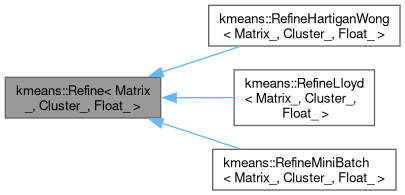kmeans::Refine< Index_, Data_, Cluster_, Float_, Matrix_ > Class Template Referenceabstract
Interface for k-means refinement algorithms. More...
#include <Refine.hpp>
Inheritance diagram for kmeans::Refine< Index_, Data_, Cluster_, Float_, Matrix_ >:

Public Member Functions | |
| virtual Details< Index_ > | run (const Matrix_ &data, Cluster_ num_centers, Float_ *centers, Cluster_ *clusters) const =0 |
Detailed Description
template<typename Index_, typename Data_, typename Cluster_, typename Float_, typename Matrix_ = Matrix<Index_, Data_>>
class kmeans::Refine< Index_, Data_, Cluster_, Float_, Matrix_ >
class kmeans::Refine< Index_, Data_, Cluster_, Float_, Matrix_ >
Interface for k-means refinement algorithms.
- Template Parameters
-
Index_ Integer type of the observation indices. This should be the same as the index type of Matrix_.Data_ Numeric type of the input dataset. This should be the same as the data type of Matrix_.Cluster_ Integer type of the cluster assignments. Float_ Floating-point type of the centroids. Matrix_ Class satisfying the Matrixinterface.
Member Function Documentation
◆ run()
template<typename Index_ , typename Data_ , typename Cluster_ , typename Float_ , typename Matrix_ = Matrix<Index_, Data_>>
|
pure virtual |
- Parameters
-
data A matrix containing data for each observation. num_centers Number of cluster centers. [in,out] centers Pointer to an array of length equal to the product of num_centersanddata.num_dimensions(). This contains a column-major matrix where rows correspond to dimensions and columns correspond to cluster centers. On input, columnjshould contain the initial centroid location for clusterj. On output, each column will contain the final centroid location for its corresponding cluster.[out] clusters Pointer to an array of length equal to the number of observations (from data.num_observations()). On output, this will contain the 0-based cluster assignment for each observation. Specifically, each entry is an index that refers to a column ofcentersand is no greater thannum_centers.
- Returns
centersandclustersare filled, and an object is returned containing clustering statistics.
Not all columns of centers may be represented in the output clusters, i.e., some clusters may be unused. The remove_unused_centers() function will rearrange the cluster assignments to more easily skip these empty clusters. In practice, empty clusters should be rare if the initial centroids are chosen appropriately.
The documentation for this class was generated from the following file:
- kmeans/Refine.hpp
Generated by